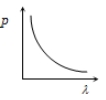The ratio of de-Broglie wavelength of a -particle to that of a proton being subjected to the same magnetic field so that the radii of their path are equal to each other assuming the field induction vector is perpendicular to the velocity vectors of the -particle and the proton is
(1) 1
(2)
(3)
(4) 2
(1) 1
(3)
Which of the following figure represents the variation of particle momentum and the associated de-Broglie wavelength?
1. 
2. 
3. 
4. 
The stopping potential as a function of the frequency of the incident radiation is plotted for two different photoelectric surfaces A and B. The graphs show that work function of A is
(1) Greater than that of B
(2) Smaller than that of B
(3) Equal to that of B
(4) No inference can be drawn about their work functions from the given graphs
The graph between intensity of light falling on a metallic plate (I) with the current (i) generated is
For a photoelectric cell the graph showing the variation of cut of voltage () with frequency (v) of incident light is best represented by
The correct curve between the stopping potential (V) and intensity of incident light (I) is
The value of stopping potential in the following diagram
(1) – 4V
(2) – 3 V
(3) – 2V
(4) – 1 V
In the following diagram if , then,
(1)
(2)
(3)
(4)
| 1. |  |
2. |  |
| 3. |  |
4. |  |
A parallel beam of light is incident normally on a plane surface absorbing 40% of the light and reflecting the rest. If the incident beam carries 60 W of power, the force exerted by it on the surface is
(1)
(2)
(3)
(4)












